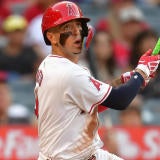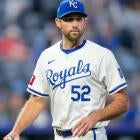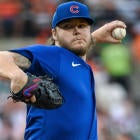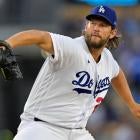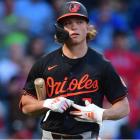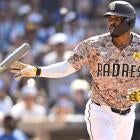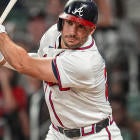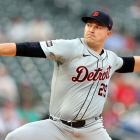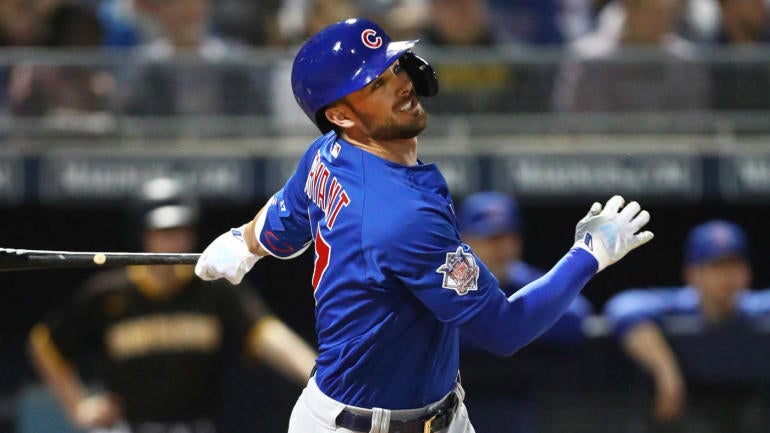
Last summer, when we were preparing for the delayed and shortened 2020 MLB season, there was a common refrain in Fantasy baseball circles. We repeated it during the sprint of the season, and it was still part of the discourse when the season ended, too.
It was a simple creed: "Don't overreact to the short season."
A full MLB season is barely long enough to say with 100% confidence whether a player's skill level has changed. That's something we have to grapple with every season when we're getting ready for drafts -- which of last year's breakouts were real, and who is going to bounce back from a tough season? Sometimes, guys just have a random bad season where everything goes wrong for them; sometimes, they just really, really hot for a few months and it skews their final numbers. We move players up and down the rankings every year based on the previous season's results, but there's always skepticism around dramatic changes in a player's profile, even when we're talking about stats in a full MLB season.
60 games in two months is, it goes without saying, not a full MLB season. And we're seeing a bit less turnover at the top of drafts this year than we did last year as a result; there are 11 players being drafted inside of the top-100 in 2021 who were outside of the top 150 in ADP in 2020, compared to 19 in the top 100 in 2020 who were outside of the top 150 in 2019. But there are still plenty of players who have seen their value change pretty dramatically based on a very small sample size in 2020.

Fantasy Baseball Draft Kit
Your ultimate baseball draft guide
Dominate your Fantasy Baseball draft with our free Draft Kit, which gives you must-have positional and Top 300 rankings in a printable format. Plus track your draft with our lineup builder and salary cap tracker.
Thanks for signing up!
Keep an eye on your inbox.
Sorry!
There was an error processing your subscription.
That's why I'm dubbing 2021 "The Year of the Bounceback" in Fantasy Baseball. So many high-profile players struggled in the once-in-a-lifetime circumstances of the 2020 season, and while some are being given a mulligan for their struggles, many are sliding down draft boards.
This means there are potentially a lot of values available in drafts this year. Obviously, some of the players who struggled in 2020 weren't flukes -- player skills aren't static, and there are going to be players' whose skill level declined in 2020 just like every season. The difference this season is we have a lot less information to go on when trying to figure out who those players are. That means we're going to be wrong a lot more in 2021 than normal, both on last year's biggest busts and breakouts.
Players who have a track record of production but struggled in 2020 are going to be one of my prime categories of players to target as a result. When you've got a chance to buy a player whose cost has dipped because of what happened in a 60-game season, I think you've got to take the chance.
Head on over to Spotify, Apple, or wherever else you consume podcasts to subscribe to Fantasy Baseball Today in 5.
These are my 10 favorite bounceback candidates for 2021, and I plan on making sure I've got at least a few of these players on each of my teams:
Player | 2020 ADP | 2021 ADP | DIFF |
36.29 | 71.89 | -35.6 | |
40.74 | 94.61 | -53.87 | |
55.32 | 110.67 | -55.35 | |
56.16 | 129.24 | -73.08 | |
58.28 | 124.26 | -65.98 | |
64.93 | 109.08 | -44.15 | |
75.5 | 156.8 | -81.3 | |
82.38 | 143.96 | -61.58 | |
86.05 | 164.28 | -78.23 | |
93.51 | 157.53 | -64.02 |
Here's the case for why each is going to bounce back:
Javier Baez -- Baez is one of the players who has talked about the impact MLB's restriction of access to in-game video last season, and it's as good an excuse as any for why a guy who had established himself as a .286/.321/.544 hitter over the previous two seasons suddenly put up an OPS below .600. With how power-speed guys are being pushed up in drafts I love the potential of grabbing Baez one round after Trent Grisham or Randy Arozarena come off the board.
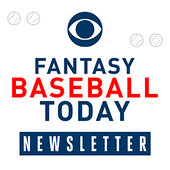
Fantasy Baseball Today Newsletter
Your Cheat Code To Fantasy Baseball
You're destined to gain an edge over your friends with advice from the award-winning FBT crew.
Thanks for signing up!
Keep an eye on your inbox.
Sorry!
There was an error processing your subscription.
Austin Meadows -- Actually, Meadows' excuse for his 2020 struggles might be even more salient than Baez's. He tested positive for COVID last July and, while his symptoms were generally mild, he missed the ramp-up period for the season plus the first 10 games. Meadows is a career .276/.345/.508 hitter even including 2020, and there's upside for 30 homers and 15 steals here -- especially if he emerges as the Rays leadoff hitter.
Chris Paddack -- Paddack was supposed to be the next big thing, and now he's outside the top 100 in most drafts. 2020 was bad, but the Padres very quickly identified a flaw in Paddack's fastball delivery that they think will play a big part in getting him back on track. Paddack relies on high fastballs to generate whiffs, but in 2020, his fastball wasn't "rising" -- it moved more like a two-seamer, and he gave up a .308 average and .658 slugging percentage against the pitch as a result. Paddack's had his ups, and he's had his downs, but now is the time to buy.
Kris Bryant -- People who don't like Bryant much for 2021 -- like my Fantasy Baseball Today co-hosts -- will point to the fact that his batted-ball profile suggests 2020 wasn't really a fluke or bad luck: He hit .206 with a .351 slugging percentage, and he had a .201 expected average and .344 expected slugging percentage, per StatCast data. But the thing is, the fact that Bryant's production matched those expectations is really the outlier:
BA | xBA | BA DIFF | SLG | xSLG | SLG DIFF | wOBA | xwOBA | wOBA DIFF | |
2015 | .275 | .233 | .042 | .488 | .472 | .016 | .371 | .352 | .019 |
2016 | .292 | .264 | .028 | .554 | .54 | .014 | .396 | .381 | .015 |
2017 | .295 | .259 | .036 | .537 | .494 | .043 | .399 | .374 | .025 |
2018 | .272 | .247 | .025 | .460 | .434 | .026 | .359 | .345 | .014 |
2019 | .282 | .245 | .037 | .521 | .459 | .062 | .380 | .347 | .033 |
2020 | .206 | .201 | .005 | .351 | .344 | .007 | .285 | .282 | .003 |
These metrics aren't perfect encapsulations of what a player does as a hitter, and Bryant is a clear example of that -- there is something about how he hits the ball that isn't being picked up here. Or, there was before 2020. My bet is, Bryant bounces back to being a strong four-category contributor, in a Cubs lineup that has several bounceback candidates.
Charlie Morton -- I wrote about why I'm expecting a bounce back from Morton when I wrote about why the 100-150 range in ADP is where I like getting pitchers, but the velocity came back after his return from shoulder injury and he was excellent in the postseason, so I'll buy a guy who was a consensus top-15 starting pitcher in the 35 range this season.
Zack Greinke -- OK, you see the 4.03 ERA and drop in average fastball velocity from 89.9 to 88.1 mph in 2020 and you're worried this is the end of the road. Greinke is 37, so it's entirely possible it is -- though he'll probably be able to throw that 54 mph eephus for another 30 years or so. But the thing is, Greinke's underlying stats were largely unchanged in 2020; in fact, in some ways, they were even better. If the diminished velocity and his age were reasons to fade Greinke in 2021, shouldn't they have had a bigger impact on him in 2020?
Victor Robles -- In an ideal world, the Nationals would probably want Robles batting leadoff, and you just love when that dovetails with what we want, don't you? Robles needs to hit, of course, something he didn't do last season when he sported a disastrous .220/.293/.315 line. But Robles won't even be 24 until nearly the end of May and he hit .255/.326/.419 in 2019. If he can just get back to that level and stays in the leadoff spot for the Nationals, Robles could be a top-50 player with the potential to steal 30 bases.
Ramon Laureano -- In 171 games between 2018 and 2019, Laureano hit .288 with 29 homers and 20 steals for the A's and he entered 2020 as a top-85 pick. As I wrote earlier in the week, Laureano could give you similar (or better, frankly) production to what we're hoping for from Trent Grisham at a significant discount.
Joey Gallo -- Gallo still hit the ball plenty hard in 2020, ranking in the top 10% in the league barrel rate and in the 85th percentile in average exit velocity. He needs to be a lot better than that to thrive, given his strikeout issues, and I'm willing to bet that the guy whose average exit velocity dropped from 94.8 to 91.2 mph in one season will bounce back. It's worth noting, Gallo did test positive for COVID prior to last season and then dealt with some soreness in his surgically repaired right wrist, which could help explain the drop.
Josh Bell -- Blame the Home Run Derby or just say it was a fluke, but Bell hasn't been the same guy since the 2019 All-Star break. But even in the second half of the 2019 season, his skill set didn't look that much different than it had during his breakout; he still had great plate discipline and still hit the ball very hard. The plate discipline abandoned him in 2020 and though he kept hitting the ball hard, Bell started hitting the ball on the ground too much, which doesn't help much. The Nationals believe they identified some tweaks in Bell's swing that can fix what went wrong, and that's enough for me to believe he can get close to the player he was in 2019 -- he finished with a .277/.367/.569 line and 37 home runs despite the second-half slump.
So which Fantasy baseball sleepers should you snatch in your draft? And which undervalued first baseman can help you win a championship? Visit SportsLine now to get Fantasy baseball rankings for every single position, all from the model that called Will Smith's huge breakout last season, and find out.


